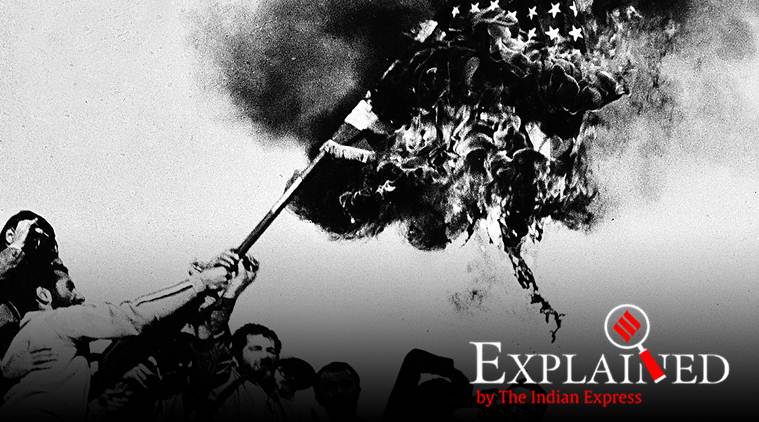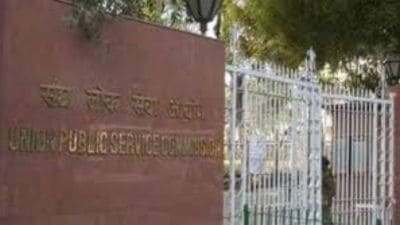- India
- International
In Baghdad US embassy storming, echoes of a siege in Tehran 40 yrs ago
What happened in 1979, and why does the US blame Iran for Tuesday’s attack on its embassy compound in Iraq?
 Hostage takers burn American flag at the embassy in Tehran in 1979.
Hostage takers burn American flag at the embassy in Tehran in 1979.
On Tuesday evening (India time), as several dozen protesters stormed the United States embassy compound in Baghdad, smashing windows and lighting fires, and a crowd of thousands thronged the streets outside chanting “Death to America”, John R Bolton, who was the US National Security Adviser until September 2019, posted on Twitter: “The attack on the US embassy in Baghdad is straight from Iran’s playbook in 1979…”
Several hours later, President Donald Trump tweeted that “The US Embassy in Iraq is, & has been for hours, SAFE!”, with “great Warfighters, together with the most lethal military equipment in the world”, present at the site. He threatened the regime in Tehran directly: “Iran will be held fully responsible for lives lost, or damage incurred, at any of our facilities. They will pay a very BIG PRICE! This is not a Warning, it is a Threat.”
The US believes the attack on the embassy compound was directed from Tehran, and led by the Kata’ib Hezbollah militia, which is different from Hezbollah in Lebanon but, like the latter, is closely aligned with the Quds Force, the overseas operations wing of the Islamic Revolutionary Guards Corps (IRGC). The Hezbollah, Kata’ib Hezbollah, and Revolutionary Guards have been designated international terrorist organisations by the US.
What happened in 1979, and why does the US blame Iran for Tuesday’s attack on its embassy compound in Iraq?
Tehran embassy seige
On November 4, 1979, youth followers of Ayatollah Ruhollah Khomeini calling themselves Muslim Students Following the Imam’s Line smashed through the gates of the US embassy in Tehran and seized the compound and the 63 American citizens present on the premises. (Another three American diplomats were seized at the Foreign Ministry.) The crisis lasted a full 444 days — until January 20, 1981, when the last batch of the 52 Americans who were taken hostage were released.

The incident — the most consequential of its kind in recent decades (along with the 2012 assault on the US embassy in Benghazi, Libya, in which the American ambassador and a foreign service officer was killed) — put the relationship between the US and Iran in a fundamentally hostile cast, the echoes of which continue to reverberate more than 40 years on. The embassy seige, a seminal event of the Islamic Revolution, cemented the perception of the ayatollahs’ regime as being intractably fundamentalist and anti-West, and has ever since been at the heart of the US narrative of Iran as a rogue outlier that has no respect for internationally accepted principles law, morality, or human rights.
The context in Iran
The last Shah of Iran, Mohammad Reza Pahlavi, who had been installed and kept in power by Western powers led by the US and the UK, had been a close American ally for decades. Under him, Iran was the West’s bulwark against the Soviet Union, and the autocratic Shah energetically pursued Western style modernisation in the country, including the suppression of religious groups. As public anger against the Shah peaked, the sprawling US embassy compound became, from the last months of 1978 onward, the scene of large protests by Iranians who perceived the US as his primary benefactor.
On January 16, 1979, the Shah fled Iran for Egypt, and on February 1, Khomeini made a triumphant return to his country after 15 years in exile. On October 22, the deposed Shah arrived in the US for medical treatment, triggering an eruption of anger on the Iranian street, which ultimately resulted in the storming of the embassy on November 4.
The unfolding crisis
Initial negotiations by representatives of President Jimmy Carter and diplomats of other countries in Iran made no headway. The country’s mood was virulently anti-American, and the fate of the hostages was also caught in a tussle between rival revolutionary factions. Mehdi Bazargan, who had been appointed Prime Minister by Khomeini, resigned on November 6. The US refused to accept the hostage takers’ key demand for the return of the Shah — and instead stopped buying Iranian oil, froze Iranian assets in America, lobbied with other countries and in the United Nations, and took Iran to the International Court of Justice (where it ultimately won).
Meanwhile, on November 17, 13 women and African American hostages were released. On July 11, 1980, another hostage who had fallen very ill, was let go. Separately, on January 28, 1980, six American diplomats who had escaped being taken hostage and had been sheltered by the senior Canadian diplomat John Sheardown, made a dramatic escape along with two CIA operatives on board a Swissair flight to Zurich. (Their story was fictionalised in Escape from Iran: The Canadian Caper (1981) and the Oscar-winning Argo (2012).
On April 24, 1980, a dangerous military attempt to fly the hostages out of Tehran failed tragically after three of the eight helicopters on the mission malfunctioned, and a fourth was involved in an accident as the US forces sought to withdraw hastily. Eight American soldiers were killed, and Iran showed their bodies on TV, to the Carter administration’s humiliation. Thereafter all diplomatic efforts ceased, and Iran tightened security around the hostages.
More Explained
EXPRESS OPINION
Apr 16: Latest News
- 01
- 02
- 03
- 04
- 05































